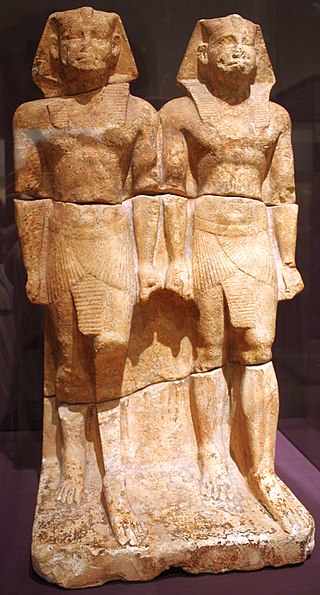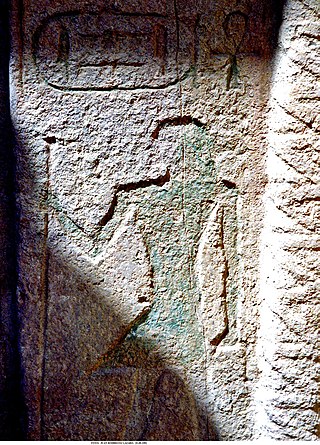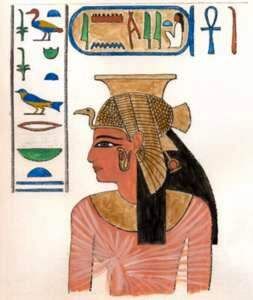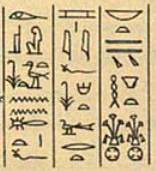
Menkauhor Kaiu was an Ancient Egyptian pharaoh of the Old Kingdom period. He was the seventh ruler of the Fifth Dynasty at the end of the 25th century BC or early in the 24th century BC.

Djedkare Isesi was a pharaoh, the eighth and penultimate ruler of the Fifth Dynasty of Egypt in the late 25th century to mid-24th century BC, during the Old Kingdom. Djedkare succeeded Menkauhor Kaiu and was in turn succeeded by Unas. His relationship to both of these pharaohs remain uncertain, although it is often conjectured that Unas was Djedkare's son, owing to the smooth transition between the two.

Nyuserre Ini was an Ancient Egyptian pharaoh, the sixth ruler of the Fifth Dynasty during the Old Kingdom period. He is credited with a reign of 24 to 35 years depending on the scholar, and likely lived in the second half of the 25th century BCE. Nyuserre was the younger son of Neferirkare Kakai and queen Khentkaus II, and the brother of the short-lived king Neferefre. He may have succeeded his brother directly, as indicated by much later historical sources. Alternatively, Shepseskare may have reigned between the two as advocated by Miroslav Verner, albeit only for a few weeks or months at the most. The relation of Shepseskare with Neferefre and Nyuserre remains highly uncertain. Nyuserre was in turn succeeded by Menkauhor Kaiu, who could have been his nephew and a son of Neferefre.

Karl Richard Lepsius was a pioneering Prussian Egyptologist, linguist and modern archaeologist.

Isesi-ankh was an ancient Egyptian high official during the second half of the Fifth Dynasty, in the late 25th to mid 24th century BC. His name means "Isesi lives". He may have been a son of pharaoh Djedkare Isesi and queen Meresankh IV, although this is debated. Isesi-ankh probably lived during the reign of Djedkare Isesi and that of his successor Unas. He was buried in a mastaba tomb in north Saqqara, now ruined.

Rashepses was a vizier from the Fifth Dynasty of Egypt. Rashepses was vizier under Djedkare Isesi. A letter directed to Rashepses has been preserved. This decree is inscribed in his tomb in Saqqara. As vizier he was one of the most important Ancient Egyptian officials. In his tomb are many titles recorded. It seems that he was first overseer of the scribes of the royal documents, overseer of the two granaries and overseer of all royal works. These are all very important titles, making him an influential official at the royal court. At the final stage of his career he became vizier. The vizier title is only preserved in two letters that are copied on the decoration of the tomb. It seems that most of his tomb was finished and after all that, he was promoted.

Akhethetep was a high dignitary of ancient Egypt who lived during the Fifth Dynasty around 2400 BC. Akhethotep and his son Ptahhotep Tjefi were senior court officials during the rule of Djedkare and of Unas (Wenis), towards the end of the 5th Dynasty. Akhethetep's titles included that of a vizier, making him to the highest official at the royal court, only second to the king. He was also overseer of the treasuries, overseer of the scribes of the king's documents and overseer of the granaries. Akhethetep was the son of Ptahhotep. His father was vizier too.

QV71 is the tomb of Bintanath, the daughter and Great Wife of Ramesses II, in Egypt's Valley of the Queens. It was mentioned by Champollion and Lepsius, and later excavated by Ernesto Schiaparelli.

QV68 is the tomb of Meritamen, the daughter and Great Wife of Ramesses II, in Egypt's Valley of the Queens. It was mentioned by Champollion and Lepsius, and later excavated by Ernesto Schiaparelli.

QV60 is the tomb of Nebettawy, the daughter and Great Wife of Ramesses II, in Egypt's Valley of the Queens. It was mentioned by Champollion and Lepsius, and later excavated by Ernesto Schiaparelli.

QV75 is the tomb of Henutmire, likely the daughter and Great Wife of Ramesses II, in Egypt's Valley of the Queens. It was mentioned by Champollion and Lepsius.

QV80 is the tomb of (Mut-)Tuya, the Great Royal Wife of Seti I, and the mother of Ramses II, in Egypt's Valley of the Queens.
Tanejemet of Tanedjemy is a King's daughter and King's Wife from the New Kingdom. She is possibly a daughter of Ramesses I and wife of Seti I.
Kaemtjenent was an ancient Egyptian official under pharaoh Djedkare Isesi in the late Fifth Dynasty, during the Old Kingdom period.
Ptahhotep Desher was an Ancient Egyptian official at the end of the Fifth Dynasty, most likely in office under kings Menkauhor Kaiu and Djedkare Isesi. His main function was that of a vizier. This was the most important office in Ancient Egypt, second only to the king. Ptahhotep also held other titles, such as overseer of the six great houses, overseer of the scribes of the royal documents and overseer of all royal works. These are all important functions, often held by a vizier.
Kay was an Ancient Egyptian official living most likely in the Fifth Dynasty. He is mainly known from his mastaba in Saqqara North. Kay hold a high number of important titles making him the most powerful of his time, only second to the king. His main office was that of a vizier. Beside being vizier, he was also holding many other important titles, such as Overseer of the treasuries, Overseer of Upper Egypt, overseer of the scribes of the king's document, overseer of the six big houses and overseer of all royal works of the king. His mastaba in Saqqara was recorded by Gaston Maspero who assigned to it the number D 19. Kay was bearing 51 titles, making him the vizier with the highest numbers of titles. Kay was the first Egyptian official with the title overseer of the six big houses. The office became one of the most important at the royal court in the later Fifth Dynasty and continued to be so during the subsequent Sixth Dynasty.
Washptah, with the second name Izi, was an ancient Egyptian official in the Fifth Dynasty under king Neferirkare Kakai. His most important title was that of a vizier, making him to the most important official at the royal court, only second to the king. Next to the office of the vizier he hold several other important positions, including overseer of the scribes of the king's document and overseer of all royal works.
Ptahhotep was an ancient Egyptian official of the Fifth Dynasty, most likely under king Djedkare Isesi. His most important office was that of a vizier, making him to the most important official at the royal court, only second to the king. Next to this important office he held further important titles, such as overseer of the treasuries, overseer of the scribes of the king's document, overseer of the six big houses and overseer of all royal works of the king.
The Statue of Metjen is on display in the Egyptian Museum in Berlin and has the inventory number ÄM 1106. The statue was discovered at Abusir in Metjen's mastaba by the Egyptian expedition (1842–1845) under the direction of the Prussian scholar Karl Richard Lepsius. The statue and the mastaba were bought to the museum in Berlin. The statue is an early example of an Egyptian statue belonging to a private individual. Metjen lived at the end of the Third Dynasty and the beginning of the Fourth Dynasty. The statue is made of granite and about 47 cm high. It is datable under king Snofru.
Akhethetep was an ancient Egyptian official mainly known from his mastaba found at Saqqara. Not much is known about Akhethetep. On the reliefs of his mastaba he bears several titles, including overseer of the great house. This was an administrative title of rather unclear function. He had also several religious titles, including priest of Maat and priest of Hathor, lady of Dendera. He had also priestly functions at the funerary cult of different kings and was Priest of Nefer-Djedkare (this is the name of the pyramid of king Djedkare and priest at Nefersut-Unas.












